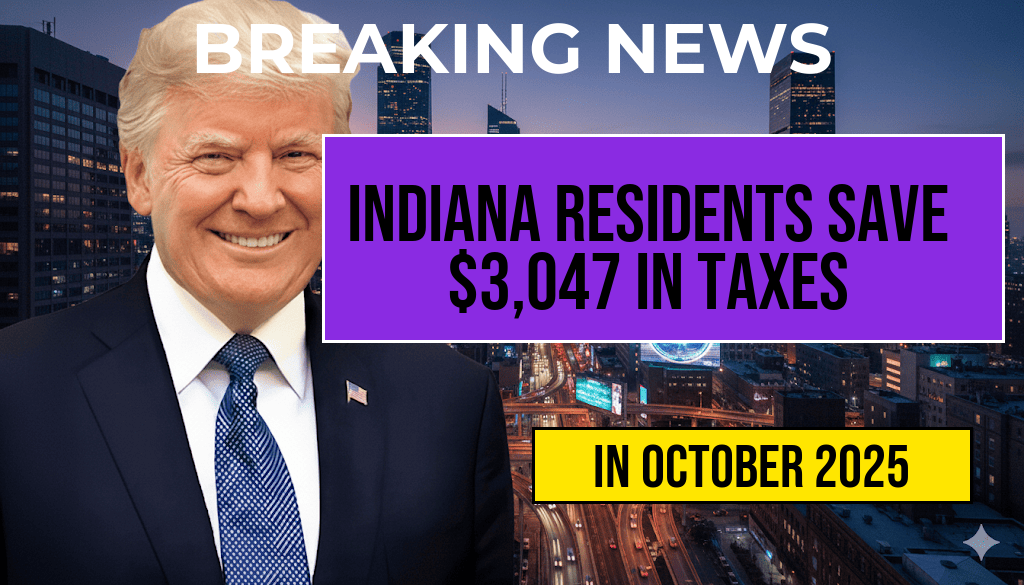Residents across Indiana are poised to see significant tax savings in 2026, with the state’s newly enacted legislation projected to reduce individual tax burdens by an average of $3,047. This legislative shift, approved by state lawmakers earlier this year, aims to stimulate economic growth and increase disposable income for families and individuals. The legislation introduces a series of tax cuts, including adjustments to income brackets, deductions, and credits, which collectively are expected to reshape Indiana’s fiscal landscape. Experts suggest that these changes will not only benefit taxpayers but could also influence migration patterns and business investments within the state.
Details of the Legislation and Its Impact
Key Provisions of the New Tax Legislation
- Reduction in Income Tax Rates: The legislation lowers the top individual income tax rate from 3.23% to 2.9%, impacting middle and high-income earners.
- Increase in Standard Deduction: The standard deduction for individuals rises by $2,000, effectively reducing taxable income for many residents.
- Enhanced Child and Family Credits: Expanded credits aim to provide relief for families, with up to $1,000 per child available in credits for qualifying households.
- Phase-Out of Certain Tax Deductions: Some itemized deductions are phased out or reduced, encouraging taxpayers to utilize standard deductions.
Projected Revenue and Budget Implications
The legislation is expected to reduce state tax revenues by an estimated $1.2 billion annually once fully implemented. State officials argue that the resulting fiscal flexibility will allow reinvestment in infrastructure, education, and public health initiatives. However, critics caution that long-term fiscal planning must account for potential revenue shortfalls amid ongoing economic uncertainties.
Economic and Social Effects
Potential Benefits for Residents and Local Economies
According to the Indiana Department of Revenue, the average tax savings of $3,047 in 2026 will significantly impact household budgets. Middle-income families, in particular, stand to benefit from the increased standard deductions and lower effective tax rates. This additional disposable income could lead to increased consumer spending, bolstering local businesses and service providers.
Migration and Business Attraction
Indiana’s competitive tax environment is expected to attract new residents and businesses seeking lower tax burdens. State officials highlight that the reforms align with strategies to position Indiana as a favorable destination for startups and relocations, especially as other states grapple with higher tax rates. This shift could bolster job creation and foster a more dynamic economic climate in the coming years.
Community and Political Reactions
Support from Lawmakers and Business Leaders
Legislators who championed the bill emphasize its role in promoting economic vitality. Senator Mark Johnson, a key supporter, stated, “Reducing taxes is essential to empower our residents and businesses to thrive. These changes will make Indiana more attractive and equitable.” Business associations have echoed this sentiment, noting the potential for increased investment and workforce stability.
Concerns and Criticisms
Opponents warn that the revenue shortfalls could hinder funding for essential services, including education and public safety. Indiana Fiscal Watch released a statement cautioning that “while tax relief is beneficial, fiscal discipline must be maintained to avoid future deficits.” Some community groups also express concern that benefits may skew toward higher-income households, potentially widening economic disparities.
Comparative Perspective and Future Outlook
Indiana’s Tax Reforms in Context
Indiana’s approach reflects a broader trend among states seeking to balance tax competitiveness with fiscal responsibility. Similar reforms in neighboring states such as Ohio and Illinois highlight the ongoing debate over optimal tax structures to support sustainable growth. For more on state tax policies, see Wikipedia’s overview of state income taxes.
Long-term Considerations
While the immediate outlook suggests positive effects for residents, the legislative changes will require careful monitoring. Budget analysts recommend ongoing evaluation to ensure that revenue adjustments align with economic growth and public service needs. The Indiana legislature has committed to reviewing the legislation’s impact periodically, with the first assessment scheduled for 2028.
Summary
| Average Tax Savings per Resident | Total State Revenue Impact | Key Benefits |
|---|---|---|
| $3,047 | $1.2 billion annually | Lower income taxes, increased deductions, expanded credits |
Indiana’s recent legislative reforms mark a pivotal shift in the state’s fiscal policy, promising notable savings for residents while prompting discussions about long-term fiscal health. As the legislation takes effect, residents and policymakers alike will observe how these changes influence Indiana’s economic trajectory over the coming years.
Frequently Asked Questions
What is the main tax savings for Indiana residents in 2026?
Indiana residents are expected to save approximately $3,047 in taxes in 2026 under the new legislation.
What changes does the new legislation introduce for Indiana taxpayers?
The legislation reduces overall tax rates and adjusts deductions, resulting in significant tax savings for residents starting in 2026.
Who will benefit most from the tax legislation in Indiana?
Middle-income and higher-income Indiana residents are projected to benefit the most from the anticipated tax reductions.
When will the new tax changes take effect in Indiana?
The new legislation will begin to impact residents’ taxes starting from the 2026 tax year.
How might this legislation impact Indiana’s state budget and economy?
The tax cuts could stimulate economic growth and increase disposable income, but may also influence state revenue and budget planning.






